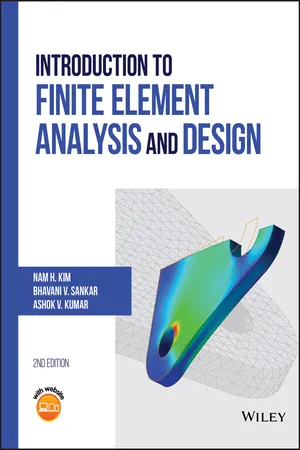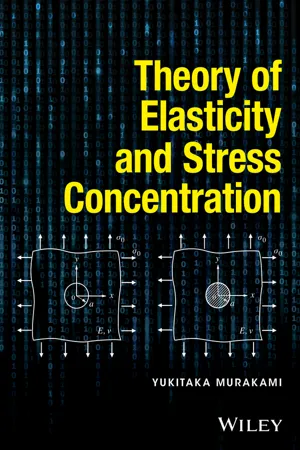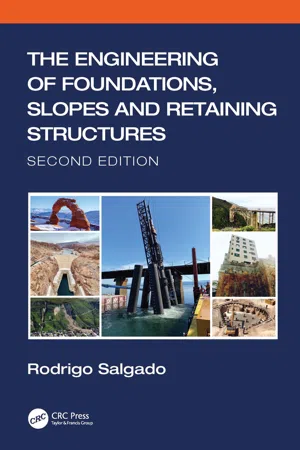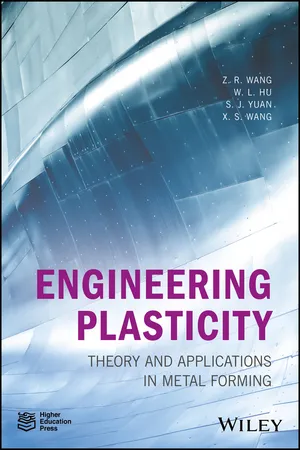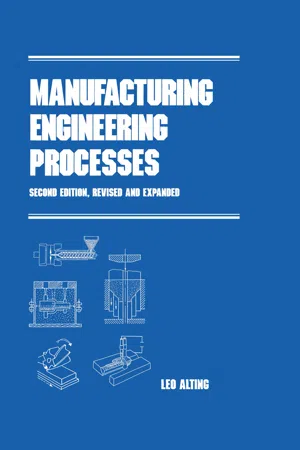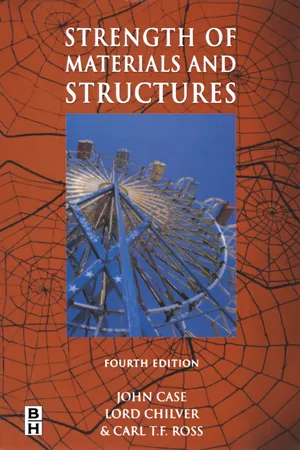Technology & Engineering
Plane Stress vs Plane Strain
Plane stress and plane strain are concepts used in the field of solid mechanics to describe the behavior of materials under different loading conditions. Plane stress occurs when a material is subjected to forces in a single plane, leading to deformation only in that plane. Plane strain, on the other hand, occurs when a material experiences deformation in all directions within a plane, typically due to three-dimensional loading.
Written by Perlego with AI-assistance
Related key terms
Related key terms
1 of 4
Related key terms
1 of 3
7 Key excerpts on "Plane Stress vs Plane Strain"
- Nam-Ho Kim, Bhavani V. Sankar, Ashok V. Kumar(Authors)
- 2018(Publication Date)
- Wiley(Publisher)
(5.54) can be simplified for certain special situations that often occur in practice. The two‐dimensional stress–strain relationship can be categorized into three cases: plane stress, plane strain, and axisymmetric. Most practical structures consist of thin plate‐like components in order to be efficient. Assume a thin plate that is parallel to the xy ‐plane. If we assume that the top and bottom surfaces of the plate are not subjected to any significant forces, that is, the plate is subjected to forces in its plane only, in the x‐ and y ‐directions, then the transverse stresses (stresses with a z subscript) vanish on the top and bottom surfaces, that is, on the top and bottom surfaces. If the thickness is much smaller compared to the lateral dimensions of the plate, then we can assume that the aforementioned transverse stresses are approximately zero through the entire thickness. Then the plate is said to be in a state of plane stress parallel to the xy ‐plane or normal to the z ‐axis. In order to derive the stress–strain relations for the state of plane stress we start with eq. (5.55). We set on the right‐hand side of the equations to obtain (5.59) Inverting the above relations, we obtain (5.60) Similar to plane stress, one can define a state of plane strain in which strains with a z subscript are all equal to zero. This situation corresponds to a structure whose deformation in the z ‐direction is constrained (i.e., w = 0), so that the following relation holds: (5.61) Plane strain can also be used if the structure is infinitely long in the z ‐direction. The stress–strain relations for the case of plane strain can be derived by starting with eq. (5.54) with the stress–strain matrix [ C ] in eq- eBook - ePub
- Yukitaka Murakami(Author)
- 2016(Publication Date)
- Wiley(Publisher)
6 Two Dimensional ProblemsThe solutions for two dimensional (2D) problems were developed first by closed form stress function methods, by numerical methods and recently by the finite element method (FEM). Although the closed form solutions obtained in the history of theory of elasticity are limited to relatively simple problems, learning and understanding such solutions is very important, not only for effective applications of the solutions to many practical problems but also for checking the validity of solutions obtained by numerical methods such as FEM.This chapter describes the basic solutions for a cylinder with a hole, stress concentration due to a circular hole, stress concentration due to an elliptical hole, crack problems and other basic problems. The problems of stress concentration are very important for the discussion of strength and fracture of various structures (see Part II ).In the following, we separate 2D problems into two typical cases. One is called the Plane Stress Problem and the other is called the Plane Strain Problem. These two cases correspond to the two extreme stress and strain conditions in 2D problems. If we study the characteristics of these two cases, we can understand the real cases which occur in the stress and strain conditions between Plane Stress and Plane Strain.6.1 Plane Stress and Plane Strain
6.1.1 Plane Stress
When we take an x–y coordinate within the plane of a plate and take a z axis in the direction of the plate thickness, plane stress is defined by the case that the stresses σx , σy and τxy are in question and other stresses are all zero. If the thickness of a plate is thin and both surfaces of the plate are free of stresses (a free surface), we may regard that the plate is in plane stress condition. The stress condition of a thin‐walled pressurized cylinder can be considered approximately close to a plane stress condition, because the internal pressure p is relatively very small compared to the axial stress σz and circumferential stress σθ - Rodrigo Salgado(Author)
- 2022(Publication Date)
- CRC Press(Publisher)
Section 4.6 some examples of how these stresses can be calculated at a point inside a soil mass from a variety of boundary loadings common in geotechnical engineering. In this subsection, we will discuss two-dimensional stress analysis, which is an easier introduction to the subject, and then follow up with three-dimensional stress analysis, required for working with more modern concepts and rigorous analyses in soil mechanics.2 Mechanicians like to use the term “representative elementary volume” to describe the smallest volume of a given material that captures its mechanical properties.3 A point in the soil is indistinguishable, for our purposes, from a representative soil element, which has a very small volume (and so is a point for practical purposes), but is sufficiently large to be representative of the soil in its mechanical behavior.4 A more proper definition of stress analysis for advanced readers would be that stress analysis aims to allow calculations of the traction (which has normal and shear components) on a plane, given the stress tensor at the point.4.1.3.1 Stress state at a point
Figure 4.2a shows a small prismatic element of soil representing a “point” within the soil. The faces of the element are aligned with the directions of the reference axes x1 and x3 . The soil element is acted upon by the normal stresses σ11 acting in the x1 direction and σ33 acting in the x3 direction, and the shear stresses σ13 and σ31 , which, due to the requirement of moment equilibrium, are equal in magnitude.5 The first subscript of a stress component represents the direction normal to the plane on which it acts; the second, the direction of the stress component itself. A stress component with subscripts taking different values is a shear stress; one with subscripts taking identical values, a normal stress. For example, σ11 is the stress acting on the plane normal to x1 in the x1 direction; that is, it is a normal stress, while σ13 is the stress that acts on the plane normal to x1 in the x3 direction (and is thus a shear stress). It is simpler (although not required) to solve problems if we adopt the practice of choosing σ11 and σ33 such that σ11 ≥ σ33 . So if the normal stresses are 1000 kPa and 300 kPa, then σ11 = 1000 kPa and σ33 = 300 kPa. Likewise, if the normal stresses are 100 kPa and −500 kPa, then σ11 = 100 kPa and σ33- eBook - ePub
Engineering Plasticity
Theory and Applications in Metal Forming
- Z. R. Wang, Weilong Hu, S. J. Yuan, Xiaosong Wang(Authors)
- 2018(Publication Date)
- Wiley(Publisher)
Chapter 8 Stress and Strain Analysis and Experimental Research on Typical Axisymmetric Plane Stress-Forming ProcessSteady axisymmetric plane stress forming processes of tubes mainly include drawing, necking, flaring, and expanding, which are characterized by, apart from the controllability of circumferential deformation by means of properly designed die cavities, the uncontrollability of through-thickness deformation. On this account, the problem how to predict and calculate thickness strains always draws close attention from engineers and, thereby, has become a typical subject in engineering plasticity.8.1 Incremental-Theory-Based Solution to Stress and Strain Distribution of Steady Axisymmetric Plane Stress-Forming Processes
Based on the incremental strain theory, combination of the yield criterion and the equilibrium equations makes it possible to achieve the stress and strain distribution in thin-walled tubes in conical die forming processes [1, 2].8.1.1 Two Expressions of Stress and Strain Distribution
There are two expressions related to stress and strain distribution. The first uses the radial distance r as the independent variable, viz.8.18.2The second uses the angle in the deformation zone on the elliptical yield locus as the independent variable, viz.8.38.4Figure 8.1 shows the popular types in thin-walled tube forming in conical dies, which include drawing, necking, flaring, and expanding. In order to analyze the stress and strain distribution during tube forming, should be cut a microelement from the test piece (see Figure 8.2 ), and established a local coordinate system in the longitudinal direction ρ, the latitudinal direction θ and the thickness direction t. It is noticeable that the through-thickness stress σt is ignored ( - Alting(Author)
- 2020(Publication Date)
- CRC Press(Publisher)
Chapter 3 . However, this assumption will not lead to any serious discrepancies at this level.A short introduction to two- and three-dimensional systems of stress is fol- lowed by discussions of the stress-strain curve, true stress, logarithmic or nat- ural strain, volume constancy, and instability. Finally, the yield criteria, which determine the stresses necessary to initiate and maintain plastic flow and the work necessary to carry out the deformation, are analyzed.4.2 TWO- AND THREE-DIMENSIONAL SYSTEMS OF STRESS
The forces that act on a solid body may be classified as either volume or mass forces or surface forces. Volume or mass forces , which include acceleration forces, are not considered in this discussion because they are usually negligible in metalworking processes. Surface forces include forces acting on the surface of every volume element, transmitted either by the interaction of the surrounding material or by external forces.When analyzing design situations for dimensioning purposes or forming pro- cesses for planning or design purposes, it is more appropriate to use the force per unit area as a measure of the load rather than the total force distributed over the area.The force per unit area (described in Chapter 2 ) is called the stress and is usually designated by the symbol σ (sigma):σ =force area( 4.1 )Considering the tensile specimen shown in Fig. 4.1 , the stress on a cross section (1) perpendicular to the longitudinal axis is defined byFIGURE 4.1 A tensile specimen with the cross-sectional area A subjected to the load P .σ =P A( 4.2 )where P is the force and A is the cross-sectional area.If a cross section (2) that is inclined at an angle θ to the longitudinal axis is considered, the mean oblique stress σm is found to beσ m=P=A θP Asin θ( 4.3 )where A θ is the cross-sectional area of cross section 2. This stress [<σ, Eq. (4.2 )] lies in the direction of the longitudinal axis of the specimen. The force P can be resolved or decomposed into two components P n perpendicular to cross section (2) and P t- eBook - ePub
- Carl T. F. Ross, The late John Case, A. Chilver(Authors)
- 1999(Publication Date)
- Butterworth-Heinemann(Publisher)
5Analysis of stress and strain
5.1 Introduction
Up to the present we have confined our attention to considerations of simple direct and shearing stresses. But in most practical problems we have to deal with combinations of these stresses.The strengths and elastic properties of materials are determined usually by simple tensile and compressive tests. How are we to make use of the results of such tests when we know that stress in a given practical problem is compounded from a tensile stress in one direction, a compressive stress in some other direction, and a shearing stress in a third direction? Clearly we cannot make tests of a material under all possible combinations of stress to determine its strength. It is essential, in fact, to study stresses and strains in more general terms; the analysis which follows should be regarded as having a direct and important bearing on practical strength problems, and is not merely a display of mathematical ingenuity.5.2 Shearing stresses in a tensile test specimen
A long uniform bar, Figure 5.1 , has a rectangular cross-section of area A. The edges of the bar are parallel to perpendicular axes Ox, Oy, Oz. The bar is uniformly stressed in tension in the x-direction, the tensile stress on a cross-section of the bar parallel to Ox being σx . Consider the stresses acting on an inclined cross-section of the bar; an inclined plane is taken at an angle θ to the yz-plane. The resultant force at the end cross-section of the bar is acting parallel to Ox .Figure 5.1 Stresses on an inclined plane through a tensile test piece.For equilibrium the resulrant force parallel to Ox on an inclined cross-section is alsoP = A σx. At the inclined cross-section in Figure 5.1 , resolve the forceA σx - eBook - ePub
Art Conservation
Mechanical Properties and Testing of Materials
- W. (Bill) Wei(Author)
- 2021(Publication Date)
- Jenny Stanford Publishing(Publisher)
In conservation, we are generally dealing with stresses and eventually things breaking when the stress reaches the material’s strength. However, in many engineering/industrial applications, and in some exceptional cases in conservation, especially of industrial heritage objects, one failure criterion is that something deforms too much. The next time the reader flies in a passenger airplane, take a look at the front of the jet engine. There, one will see the so-called fan turning. In operation, each fan blade will be loaded by a centrifugal force, which translates into a stress, which further translates into strain of the blade during flight. It is not particularly pleasant if the strain is so great that the fan blade comes in contact with the turbine engine housing. Thus, analogous to the force/stress situation, engineers who design these parts cannot go to suppliers and expect them to tell them how much a material will lengthen under a given force. They must translate that into strain under a given stress. The supplier can then provide information on the strain behavior of materials, information which is useful for every client.2.3 The Relationship between Stress and StrainStress and strain are related as one might expect. As the force is increased for the tensile test discussed in Fig. 2.1 or 2.6 , a graph will be obtained showing the relationship between the applied force on the specimen and the change in length for a typical metal (see Fig. 2.8a ). These results can be calculated into stress and strain based on the original load-carrying area of the specimen, A0 , and the original length of the specimen l0 , as defined in Fig. 2.6 . This results in a so-called engineering stress-strain (σ-ε) diagram as shown schematically in Fig. 2.8b .Figure 2.8 Schematic (a) load elongation and (b) stress-strain diagrams for a typical metal.For most metals, the increase in strain with an increase in stress begins as a straight line. This is called “linear” behavior. This part of the graph also describes something known as elastic behavior. If you stressed the material to, say point 2 in Fig. 2.8b and then unstressed it, the specimen would go back to its original length. A material is thus called elastic in technical terms when it returns back to its original form after being deformed. If the stress-strain curve is a straight line as in the lower part of Fig. 2.8b , we say that the material shows linear-elastic behavior.At a certain point for metals, the stress level, σy , the curve starts to bend and eventually reaches a maximum at the stress level, σUTS in the tensile case, or more generally, σf . The curve then bends down to the X which marks the point at which the specimen breaks or technically, fractures
Index pages curate the most relevant extracts from our library of academic textbooks. They’ve been created using an in-house natural language model (NLM), each adding context and meaning to key research topics.
Explore more topic indexes
Explore more topic indexes
1 of 6
Explore more topic indexes
1 of 4
